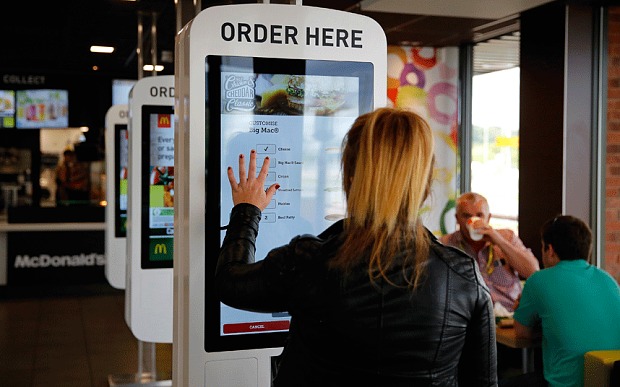
Somewhere in a dark research lab in Oak
Brook, Illinois, Ronald McDonald is working on further developments in retinal
scans, finger-prints, and facial recognition. The latest technology in use at
my local McDonald’s is just one step away from using this technology.
Brook, Illinois, Ronald McDonald is working on further developments in retinal
scans, finger-prints, and facial recognition. The latest technology in use at
my local McDonald’s is just one step away from using this technology.
Recently, I walked into a McDonald’s in
Calgary, Alberta and was confused about how I should order. There was still one
person at a till at the counter, but there were six shiny, new, touch screens
where I could place my order as well. I could sort through categories and
touch pictures of my favourite burger, drink, and fries, place my order and pay
for my meal. It was a surprisingly fast and efficient process. I was given an
order number and the factory in the back of the restaurant (still an assembly
line of people – for now) put together my order. When it was ready, my order
number showed up on a screen above the counter and a smiling host handed me a
tray carrying my meal.
Calgary, Alberta and was confused about how I should order. There was still one
person at a till at the counter, but there were six shiny, new, touch screens
where I could place my order as well. I could sort through categories and
touch pictures of my favourite burger, drink, and fries, place my order and pay
for my meal. It was a surprisingly fast and efficient process. I was given an
order number and the factory in the back of the restaurant (still an assembly
line of people – for now) put together my order. When it was ready, my order
number showed up on a screen above the counter and a smiling host handed me a
tray carrying my meal.
I thought about how they could take this
process to the next level. A number of mechanisms could be used to identify a
person when they walked into the restaurant (thus, the research in Illinois);
something as simple as giving each person a unique number and pin with which they
could log in to a terminal could work. Then, the device could ask you if you
wanted your usual order or something different (most of us are creatures of
habit when it comes to fast-food) and streamline the process further. The
terminal could be linked to your usual method of payment and instantly your
order would be placed. Now that would be “fast-food!”
process to the next level. A number of mechanisms could be used to identify a
person when they walked into the restaurant (thus, the research in Illinois);
something as simple as giving each person a unique number and pin with which they
could log in to a terminal could work. Then, the device could ask you if you
wanted your usual order or something different (most of us are creatures of
habit when it comes to fast-food) and streamline the process further. The
terminal could be linked to your usual method of payment and instantly your
order would be placed. Now that would be “fast-food!”
Of course we might ask some questions about
this process. What about the number of employees at the counter? Where will
they work if not at McDonald’s? Perhaps they will work at the factories
producing facial recognition cameras. What about the personal, human, element?
How personal is the usual exchange at any till? “Hello, can I take your order?
Big Mac, fries, and coke. That will be $X.YY. Thank you. Have a nice day.”
this process. What about the number of employees at the counter? Where will
they work if not at McDonald’s? Perhaps they will work at the factories
producing facial recognition cameras. What about the personal, human, element?
How personal is the usual exchange at any till? “Hello, can I take your order?
Big Mac, fries, and coke. That will be $X.YY. Thank you. Have a nice day.”
We have asked these types of questions
since before Henry Ford started building cars on an assembly line. Those who
lamented the loss of personal craftsmanship and the human touch have been labelled
“Luddites” for about the same length of time. Yet, those questions are still
worth asking. There may be a place for automated systems as well as a place for
old-fashioned craftsmanship, customer service, and the personal touch. Perhaps
we should think about the industries where each type of service is appropriate:
restaurant chains, the health industry, manufacturing, book sales, … Might we
slow down long enough to make some informed decisions rather than let
technology take the driver’s seat? What kind of society do we truly desire? We
need to ask these questions before they are answered for us. For now, I will go back to quietly eating my Big Mac, ignoring everyone around me while I check Facebook on my phone.
since before Henry Ford started building cars on an assembly line. Those who
lamented the loss of personal craftsmanship and the human touch have been labelled
“Luddites” for about the same length of time. Yet, those questions are still
worth asking. There may be a place for automated systems as well as a place for
old-fashioned craftsmanship, customer service, and the personal touch. Perhaps
we should think about the industries where each type of service is appropriate:
restaurant chains, the health industry, manufacturing, book sales, … Might we
slow down long enough to make some informed decisions rather than let
technology take the driver’s seat? What kind of society do we truly desire? We
need to ask these questions before they are answered for us. For now, I will go back to quietly eating my Big Mac, ignoring everyone around me while I check Facebook on my phone.